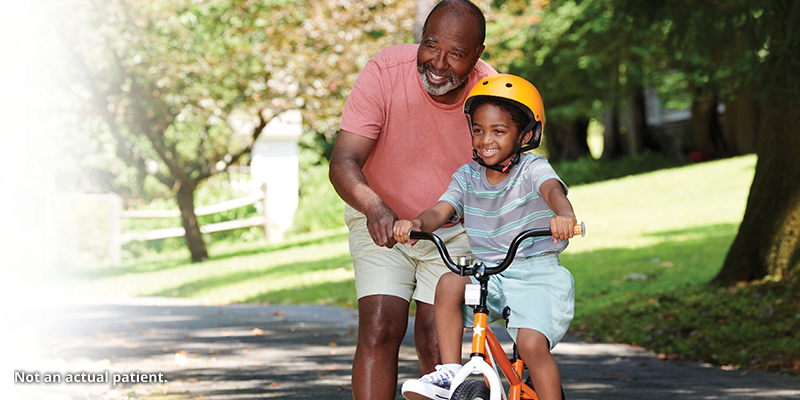
SIDE EFFECTS WITH
NINLARO® (IXAZOMIB)

Know potential side effects
It’s important to know about the most common side effects to expect when you or your loved one are taking the NINLARO treatment combination* so that you can take steps to manage any side effects that occur with your healthcare provider.
*NINLARO + lenalidomide + dexamethasone.
The NINLARO treatment combination† has been available since 2015 and has a well-established safety profile
In the clinical study, the side effects with the NINLARO treatment combination†were comparable to side effects with the lenalidomide + dexamethasone combination† alone.
NINLARO may cause serious side effects, including:
- Low platelet counts (thrombocytopenia) are common with NINLARO and can sometimes be serious. You may need platelet transfusions if your counts are too low. Tell your healthcare provider if you have any signs of low platelet counts, including bleeding and easy bruising.
- Stomach and intestinal (gastrointestinal) problems. Diarrhea, constipation, nausea, and vomiting are common with NINLARO and can sometimes be severe. Call your healthcare provider if you get any of these symptoms and they do not go away during treatment with NINLARO. Your healthcare provider may prescribe medicine to help treat your symptoms.
- Nerve problems are common with NINLARO and may also be severe. Tell your healthcare provider if you get any new or worsening symptoms including: tingling, numbness, pain, a burning feeling in your feet or hands, or weakness in your arms or legs.
- Swelling is common with NINLARO and can sometimes be severe. Tell your healthcare provider if you develop swelling in your face, arms, hands, legs, ankles, or feet, or if you gain weight from swelling.
- Skin reactions. Rashes are common with NINLARO. NINLARO can cause rashes and other skin reactions that can be serious and can lead to death. Tell your healthcare provider right away if you get a new or worsening rash, severe blistering or peeling of the skin, or mouth sores.
- Thrombotic microangiopathy (TMA). This is a condition involving blood clots and injury to small blood vessels that may cause harm to your kidneys, brain, and other organs, and may lead to death. Get medical help right away if you get any of the following signs or symptoms during treatment with NINLARO: fever, bruising, nose bleeds, tiredness, or decreased urination.
- Liver problems. Tell your healthcare provider if you get these signs of a liver problem: yellowing of your skin or the whites of your eyes; pain in your right upper stomach-area (abdomen).
Other common side effects of NINLARO include low white blood cell counts (neutropenia) and bronchitis.
Tell your healthcare provider if you get new or worsening signs or symptoms of the following during treatment with NINLARO:
- skin rash and pain (shingles) due to reactivation of the chicken pox virus (herpes zoster)
- blurred vision or other changes in your vision, dry eye, and pink eye (conjunctivitis)
These are not all the possible side effects of NINLARO. Talk to your healthcare provider for medical advice about side effects. You may report side effects to Takeda by calling 1-844-217-6468 or emailing GlobalOncologyMedInfo@takeda.com or to the FDA at 1-800-FDA-1088.
Manageable tolerability was seen with the NINLARO treatment combination†
The majority of people were able to continue taking NINLARO
10% of people stopped taking NINLARO permanently due to an adverse reaction
Most people did not need to reduce their starting dose of NINLARO
†The NINLARO treatment combination included NINLARO + lenalidomide + dexamethasone; the lenalidomide + dexamethasone combination included placebo + lenalidomide + dexamethasone.
Frequently asked questions about side effects
How long does NINLARO stay in your system?
It was shown in a study that it took about 9 ½ days for the amount of NINLARO in people’s bodies to reduce by half. The time that it takes is not an exact figure and may vary a lot between different people.
What are the side effects of NINLARO on eyes?
The most common adverse reactions of the eyes reported by patients taking the NINLARO treatment combination* in a clinical study were cataract (15%), pink eye (conjunctivitis) (9%), blurred vision (7%), and dry eye (6%).
Does NINLARO cause weight gain?
NINLARO may cause swelling which can result in weight gain. Tell your healthcare provider if you develop swelling in your arms, hands, legs, ankles, or feet, or if you gain weight from swelling.
Does NINLARO cause hair loss and fatigue?
Hair loss and fatigue were not frequently reported side effects in the NINLARO clinical study.
Does NINLARO cause a rash?
Rashes are common with NINLARO. NINLARO can cause rashes and other skin reactions that can be serious and can lead to death. Tell your healthcare provider right away if you get a new or worsening rash, severe blistering or peeling of the skin, or mouth sores.
Does NINLARO cause diarrhea?
Diarrhea is common with NINLARO, and can sometimes be severe. The good news is that diarrhea can generally be managed. If you experience diarrhea while taking NINLARO, call your healthcare provider and they may prescribe medicine to help treat your symptoms.
Make sure to tell your healthcare provider if you get new or worsening signs or symptoms during treatment with NINLARO.

Managing side effects
There are steps that you may wish to discuss with your healthcare provider to help manage some of the most common side effects that you may experience when taking NINLARO in combination with lenalidomide + dexamethasone.
- Nausea and vomiting: there are many ways to manage nausea/vomiting, including lifestyle changes such as changing some things you eat or drink. Ask your healthcare team for recommendations.
- Constipation: after talking with your healthcare provider, you may be asked to modify your diet to include more liquids or change certain foods to reduce constipation.
- Diarrhea: ask your healthcare team for specific recommendations for coping with diarrhea. Your team may suggest you eat certain foods and make changes to your overall diet to help reduce diarrhea.
- Rash: it is important to immediately report rash or any skin changes to your healthcare team. Do not diagnose or treat yourself to avoid making the rash worse.
Talking to your doctor about side effects
Ask your healthcare provider if you have any questions about side effects or are having trouble managing side effects. Contact your healthcare provider immediately if you experience any serious side effects.
Lab test tracker
Details on common multiple myeloma tests and a place to record your values.